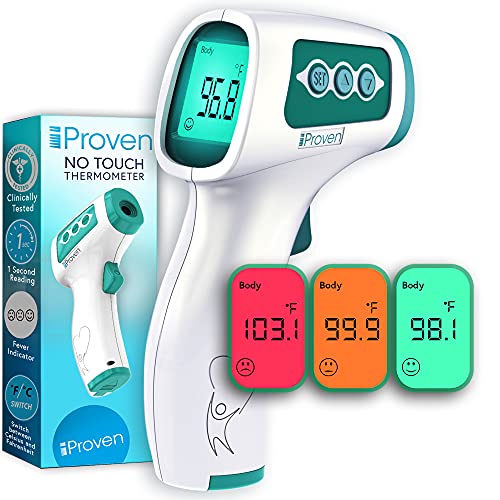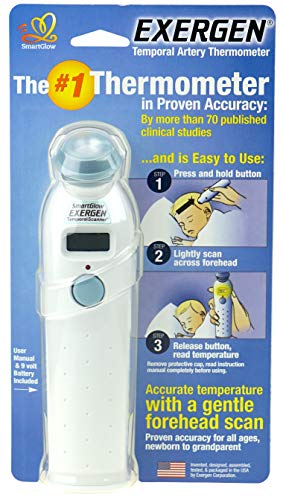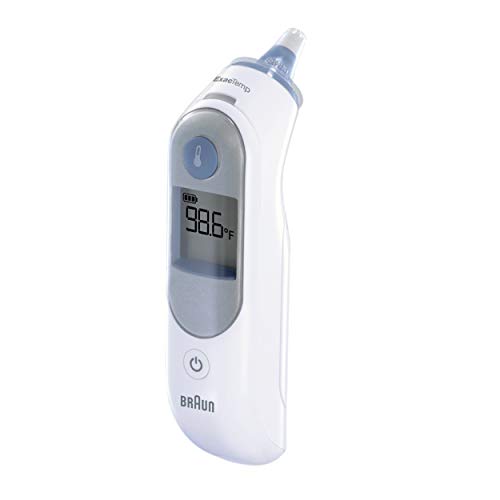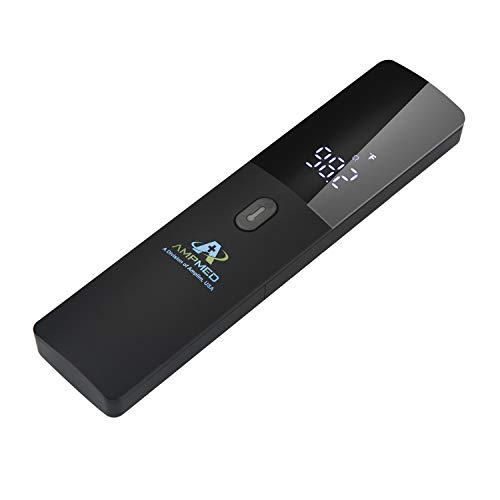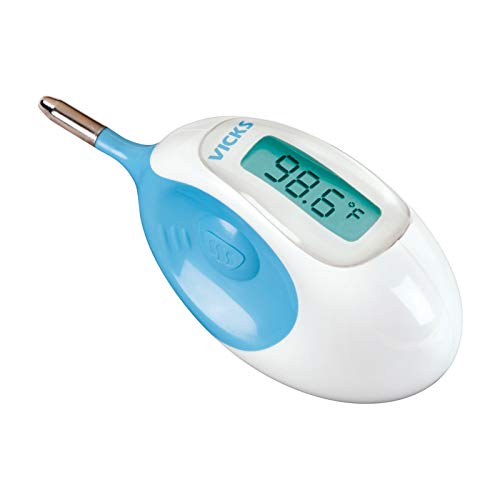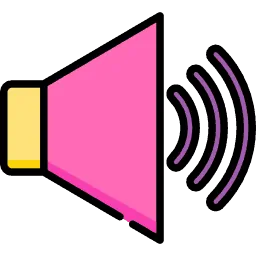When you suspect your baby is sick, there’s no room for error.
You need precision and accuracy to make the best decisions for your child. But many baby thermometers have mixed reviews, and there are so many different styles to choose from. It can be difficult to know which thermometer will be best for your baby.
As moms who have been in this position ourselves, we’ve made it our goal to find the best baby thermometers that are safe, accurate, and affordable.
We’ve listened to what hundreds of parents have had to say about the models that worked for them and those that didn’t. We’ve come up with this list of eight reliable baby thermometers that stand out above the rest, so you can rest assured you’re making the best decisions for your baby when they’re not feeling well.

- Two-year warranty
- Immediate temperature reading
- Celsius or Fahrenheit reading

- Easy to use
- Forehead readings
- Accurate readings even at a distnce

- Highly accurate
- Can be used on sleeping baby
- Backlit screen for night use

- Quick results
- Has positioning aid for accuracy
- Pre-warmed tip

- Designed for all ages
- Simple sleek design
- Reads instantly

- Multiple modes
- Stores up to 35 temperature readings
- Fever alarm feature

- Backed by FSA, HSA, and FDA
- One-minute auto shutdown
- Fever-detection system
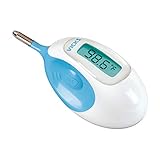
- Accurate
- Works quickly
- Prevents accidental injury
The Best Baby Thermometers of 2023
These are our favorite infant thermometers currently on the market.
Amplim Medical Grade Digital Infrared Thermometer
Best Forehead Thermometer for Babies
The Amplim Forehead Thermometer has an ergonomic design that includes a simple button activation and a large, easy-to-read backlit display. It stores up to 32 readings, so you can keep track of your baby’s changes in temperature.
This thermometer is an eligible product if you’re looking for items covered by an FSA or HSA.
What’s more, this model is even appropriate to use on newborns. It doesn’t need a disposable probe cover, and readings are taken lighting-fast in less than one second.
Pros
- FSA/HSA eligible.
- Readings are taken in one second.
- Choose between Celsius or Fahrenheit.
Cons
- Display too dim in well-lighted room.
Our Ratings
iProven Infrared Lens Thermometer
Best Infrared Thermometer for Baby
This thermometer can be used as a forehead thermometer. It takes a reading quickly within 1 second at a distance of 0.4 to 2 inches. Operating the device is a breeze since all you have to do is press a single button; it leaves little room for confusion.
It beeps after the reading is taken, so you know that it’s done, and it sounds an alarm when a fever is detected. The temperature display is backlit, so you can view it in the dark, and the display is large and centralized, so you probably won’t have any trouble reading the numbers.
Pros
- Easy to use.
- The display is large and backlit.
- There is a fever indicator.
- Waterproof and easy to clean.
Cons
- You cannot turn off the beep.
- It’s a more expensive option.
Our Ratings
Exergen Temporal Artery Thermometer
Best Temporal Artery Thermometer for Baby
Little kids are constantly getting ear infections, so it’s nice to have an option that allows you to easily and comfortably take your child’s temperature when they’re sick with one.
While ear thermometers can be inaccurate during ear infections — or plain uncomfortable to the inflamed ear — a gentle swipe across the forehead with this thermometer will give you a reading that has been proven by Harvard Medical to be more accurate than ear temperatures. Another study also showed it was as accurate as a rectal temperature, which has always been the standard for infants.
An indicator will tell you if the scan was incorrect (ensuring accuracy), and a backlit display will let you read the result even if the room you’re in is dark. And with a programmable beeper, you can decide whether you want it to make noise or not, depending on how sensitive your baby is to sounds.
Pros
- It’s highly accurate.
- You can use it on a sleeping baby.
- It has a backlit screen for night use.
- You can program it to beep if desired.
Cons
- There’s no colored fever indicator.
- The display is a little small.
- It’s one of the pricier options.
Our Ratings
Braun Digital Ear Thermometer
Best Ear Thermometer for Baby
Though ear thermometers are quick and easy to use, they can be inaccurate if positioned incorrectly. This thermometer solves that problem by including visual and audible signals to indicate that it’s positioned correctly, ensuring an accurate read every time.
The tip also pre-warms to prevent readings from being influenced by external factors, and the flexible tip ensures your baby stays comfortable. Readings are taken in seconds, meaning you won’t have to wrangle your baby for very long to learn their temperature.
Pros
- It’s fast.
- It has a positioning aid for accuracy.
- You can choose between Celsius and Fahrenheit.
- The tip is pre-warmed.
Cons
- It requires disposable lens filters (additional money).
- The screen is not backlit.
- There’s no audible indicator after reading is complete.
- There’s no fever warning indicator.
Our Ratings
iHealth No-Touch Digital Forehead Thermometer
Best Non-Contact Baby Thermometer
This infrared device will measure any temperature in one quick second — without risking cross-contamination since it doesn’t even have to touch a person to make a reading. You can use it for babies, children, or adults.
It has a sleek display with a quiet vibrating indicator if fever is detected.
The single button makes operation a breeze, and since you don’t even have to touch your child to take their temperature, you can do so without disturbing your little one’s sleep.
Pros
- Designed for all ages with environmental temperature compensation sensor.
- With memory feature.
- It reads instantly.
- Vibrating fever alert indicator.
- Simple sleek design.
Cons
- Requires 2 AAA batteries.
Our Ratings
No Touch Thermometer
Best Thermometer for Whole Family
Fevers can spread like wildfire throughout a home, and you don’t need to be rummaging around for multiple thermometers when everyone is sick. With this forehead and ear thermometer, you can take everyone’s temperature quickly and safely.
Simply choose which reading you’d like with the press of a button. The temperature is taken in a single second and displayed on the digital readout so there’s no second-guessing. It even has a fever alert and will turn red at high temperatures.
We love that you can use the forehead reader on your littlest baby and then the ear reader on your older children. If you’re a mom with lots of littles running about, this thermometer makes life a lot easier.
Other features include Celsius to Fahrenheit conversions and a storage capacity of 35 readings. You’ll be able to use it for years to come.
Pros
- Multiple modes allow for safe and accurate readings on anyone of any age.
- Store up to 35 temperature readings.
- Fever alarm lets you know when baby’s temperature is too high.
Cons
- Readings can be inconsistent as you can use this thermometer in two ways.
Our Ratings
Amplim Hospital Medical Grade Infrared Digital Thermometer
Best Clinically Tested Thermometer
When your baby is sick, you don’t have time to double or triple check their temperature. You need accurate and consistent results immediately. This clinically tested thermometer can be relied on to give clear and fast measurements.
A lot of thermometers claim to work this way, but we like the scientific backing of this one. You can never be too careful when it comes to the health of your baby and family.
This thermometer takes forehead measurements. Forehead readings are especially good for when your baby is fussy or asleep. Simply swipe the thermometer across your baby’s forehead for a super quick measurement.
The backlight will flash green if your baby’s temperature is in the safe zone. If your baby has a fever, it will turn bright red. With this system, you can get the answers you need and take action fast.
If you’re looking for an item with coverage, this thermometer is FSA and HSA eligible.
Pros
- Backed by CE and FDA standards, so you can be assured of accurate results.
- FSA/HSA approved.
- One minute auto shut down which is battery efficient.
- Fever-detection system alerts you to high temperatures.
Cons
- Reads forehead measurements only.
Our Ratings
Vicks Baby Rectal Thermometer
Best Rectal Baby Thermometer
This thermometer was designed with your baby’s body in mind. The short probe guards against over-insertion, which could cause accidental harm to your baby. And you’ll only have to keep them still for about 10 seconds before it gets a reading and shows it in the backlit digital display.
Parents who use this thermometer swear by its accuracy and ease of use. If you’re hesitant to take a rectal thermometer reading on your baby, with this device, you’ll know you’re getting the most accurate reading in a non-invasive and comfortable way.
Pros
- It’s accurate, so you can trust the reading.
- Works quickly.
- The short probe prevents accidental injury.
- It has a backlight.
Cons
- Because it’s for rectal use only, this isn’t very versatile.
- There’s no audible indicator to let you know when the reading is complete.
Our Ratings
Do You Need a Baby Thermometer?
Babies need so much extra gear, so it’s easy to assume that a baby-specific thermometer is just another gimmick. Though you may be tempted to use a thermometer you already have, that would be a mistake. The differences between standard thermometers and baby thermometers are noteworthy:
- Regular oral thermometers aren’t appropriate because babies cannot hold them under their tongues. You may think you can use it to monitor a temperature under the arm, but that’s one of the least accurate ways to measure a baby’s temperature (1).
- If you have an ear thermometer, you need one manufactured for a small ear canal to ensure an accurate reading.
- If you have an older glass mercury thermometer, it can be dangerous if it breaks and the mercury is inhaled. Mercury exposure has been linked to neurological problems and other serious health issues (2).
Purchasing a thermometer designed with babies in mind will help keep them safe and ensure you get an accurate temperature reading every time you suspect a fever.
Types of Baby Thermometers
You have many different options when choosing a thermometer for your baby (3):
Digital Thermometer
A digital thermometer has an electronic sensor on one end and a digital readout on the other. You can use digital thermometers in several ways: orally, rectally, and axillary (under the arm).
Safety First
Digital thermometers are not the best choice for babies because:
- It’s near impossible to take an oral temperature on a baby.
- Axillary temperature is one of the least accurate ways to take a temperature.
Glass Thermometer
This looks like the typical thermometer you may remember from your childhood. You place it under your tongue, and the mercury rises to indicate your body’s temperature.
However, modern thermometers no longer use mercury, but some are manufactured in a similar design with a non-mercury substitute.
Safety First
Just like with digital thermometers, you can use glass thermometers to take an oral, rectal, or axillary temperature.
Ear Thermometer
Ear thermometers take a baby’s temperature quickly by sensing the infrared heat that comes from inside the ear.
However, there are some factors involved in getting an accurate reading:
- The ear must be clear of wax build-up.
- You must insert the thermometer correctly.
- It must be appropriately sized for the child’s ear canal.
- The child should be older than three months to ensure accuracy.
Temporal Artery Thermometer
Also known as a “forehead thermometer,” this type of thermometer measures the infrared heat that comes off the head by sensing the temporal artery in the forehead.
Recent research indicates that these thermometers are accurate enough for use with newborns (5).
How to Choose a Baby Thermometer
When choosing a baby thermometer, keep the following things in mind:
How to Use a Baby Thermometer
Remember
The way you use your thermometer will depend on the kind you have:
- For a rectal reading: Gently insert the tip only about a half-inch to an inch into your baby’s rectum (not simply between the cheeks!) and wait for the beep. A dab of lubricant can help ease the process.
- For an underarm reading: Remove clothing on one arm, place the thermometer high into the armpit, and hold the arm back in place until the reading is complete. Make sure that only skin touches the thermometer tip.
- For a temporal artery reading: Place the thermometer on the forehead between the eyes, and press the button when your baby is still for a second. There’s no need for the device to touch your baby’s skin.
- For an oral reading: Position the thermometer under the tongue and ask the child to hold their mouth closed until the reading is complete. Make sure the tip is touching the tissue of the tongue and not up against the teeth or in the open air.
- For an ear reading: Gently stabilize your child’s head, pull the ear up and backward to open the ear canal, and insert the device tip inside. Be careful not to jam it in, but at the same time, ensure it’s touching the ear evenly, with the tip straight and not pointing up or down. Press the button, wait for the beep, and remove. You may want to use a cotton swab with some alcohol to sanitize the tip after use.
Oral and ear readings are best used for older children (1 to 3 years old), and rectal or axillary readings are best for newborns and younger babies.
It’s a good idea to get two different kinds of thermometers so you can confirm any reading. If the temperatures you get are quite different, take an average of both or wait a while to take another reading.
It’s normal for even very accurate devices to have slight variations, so avoid taking temperatures repeatedly. You’ll only stress yourself out, and your baby might not appreciate the extra poking and prodding.
The Bottom Line
While there are plenty of choices on the market, our top pick for the best infant thermometer is the Amplim Medical Grade Non-Contact Thermometer. Not only is the display large and easy to read, but it changes color to notify you of a fever, and beeps when the cycle is complete to let you know a reading has been taken.
It can also switch between Celsius or Fahrenheit and can be used as a forehead thermometer (for your infant) or an ear thermometer (for everyone else). It’s the perfect all-around, easy-to-use, and accurate thermometer for your whole family.
Having a sick baby is never fun, but knowing you’re able to monitor their temperature accurately can give you peace of mind.


